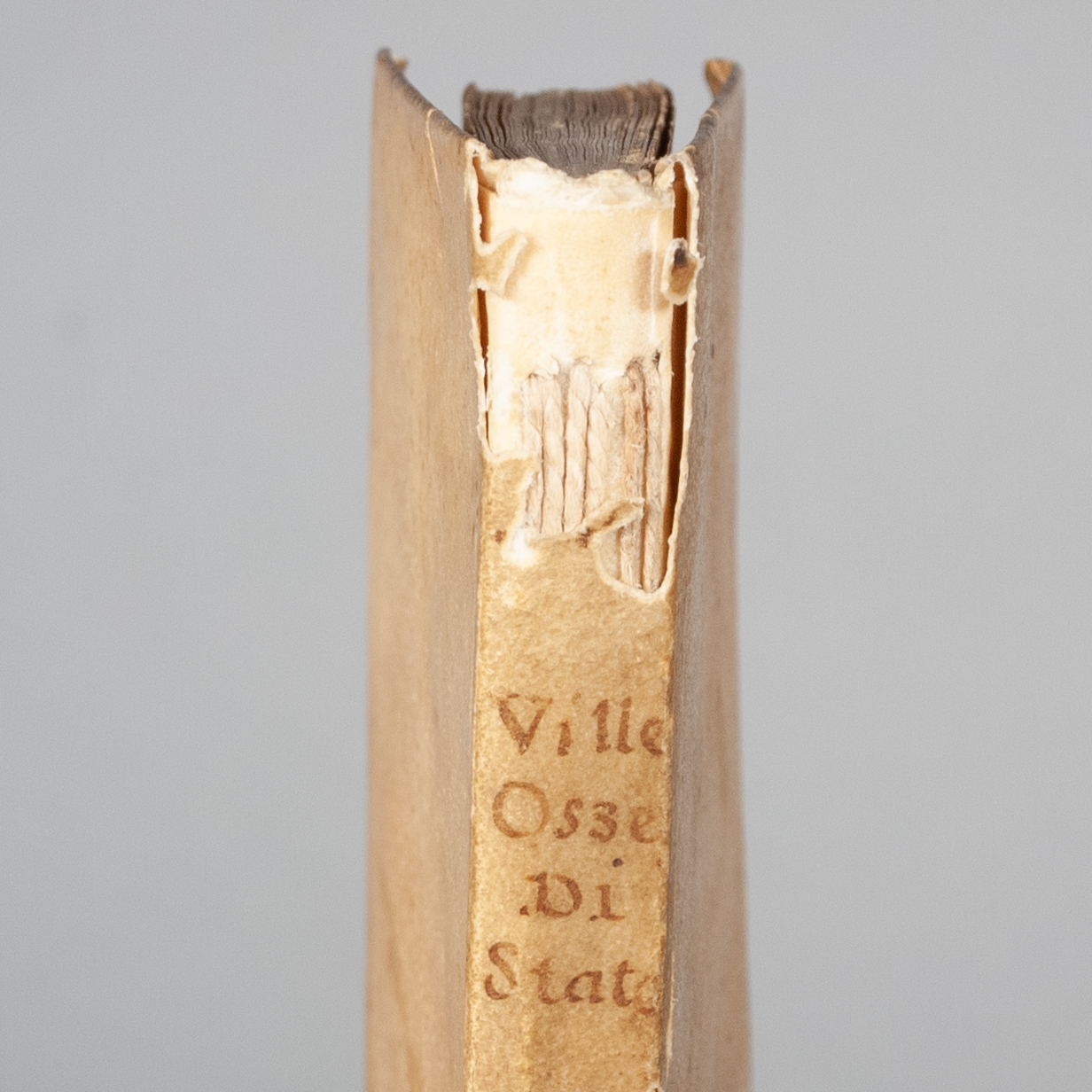Most deft diplomat



Most deft diplomat
Osservationi di stato e di historia sopra la vita e i servigii del Signor di Villeroy di Pietro Mattheo; tradotto di francese in italiano
by Pierre Matthieu | translated by Giovanni Bernardo della Bastarderie
Modena: Giulan Cassiani, 1618
136, [8] p. | 12mo | A-F^12 | 136 x 77 mm
First edition in Italian, and apparently the only recorded copy (though Barzazi does call attention to this edition). Some half dozen editions of the Italian translation appear with imprints ranging from 1619 to 1638. The work is a translation of the author’s Remarques d'estat et d'histoire sur la vie et les services de Monsieur de Villeroy by Giovanni Bernardo della Bastarderie, French tutor to the house of Cardinal Alessandro d’Este. With a woodcut printer’s device at end; a couple of head-pieces and initials. Last three leaves are blank. ¶ Matthieu here recounts the life of Nicolas de Neufville, seigneur de Villeroy (1543-1617), a remarkably deft secretary of state. Despite ceaseless conflict associated with the French Wars of Religion, Villeroy managed to serve four French kings during his career, earning Professor Nicola Sutherland’s label as the most distinguished of all sixteenth-century French secretaries. He engendered the favor of Catherine de Medici, wrote poetry, and ended a brief war between his current and future employers (Henry III and Henry IV). ¶ Matthieu himself served as principal historiographer to the court of Henry IV from 1598 until his death in 1621. “Matthieu is especially noted for expressing his opinions on writing about contemporary events during the reign of Henri IV…Regarding his duty as an historian, Matthieu believed that he should have no other passion save truth…He valued order, clarity and sound judgment the most for writing eloquent history” (Weiss). As a Frenchman, Matthieu "won, across the Alps, a public success that no author of his time has equaled” (Zilli; translated). Zilli ascribes his Italian success to a cultural climate that was “very sensitive to any form of ‘political’ thought,” and perhaps because Matthieu’s Italian translations primarily came from Venice, which had recognized Henry IV’s royal legitimacy when Rome still considered him a Protestant heretic. ¶ No copies in OCLC, SBN, or KVK.
CONDITION: Early full vellum; title in ink on spine. Light soiling to the vellum, but a strong copy. ¶ Insect damage to the spine covering has partially exposed a long-stitch structure sewn on a single vellum long-stitch guard (see Spitzmueller fig. H.16 for an example). Surviving examples of this simple structure suggest it was a standard technique employed by binders in Italy, Germany, and the Low Countries for at least three centuries.
PROVENANCE: Title page bears the ink stamp of the Ministero della Istruzione Pubblica del Regno d’Italia, ca. 1873-1874. On verso of the title is the 18th-century printed label of one Brother Philipp, originally from Poggio Mirteto but here situated at a monastery in Veroli (“Ad simplicem usum F. Philippi a Podiomirteto Lect. Jubil. iteratò min. provi. ac bis definitoris gen. nunc spectat ad Biblioth. S. Martini Verul”). Both are towns in the Lazio region, which was annexed to the Kingdom of Italy after the capture of Rome in 1870. Closure of Lazio’s religious organizations shortly followed annexation. As part of the closure process, religious libraries were ceded to the government and their books marked with the ink stamp found on the present title page (Sguario). ¶ Shelf mark (35) inked on spine.
REFERENCES: Pamela J. Spitzmueller, “A Visual Dictionary of Traditional Long- and Linkstitch Bookbinding Terminology,” Suave Mechanicals v. 2, p. 387, 423; Antonella Barzazi, “’Si quid e Gallia afferatur, avide lego,’ Reti intellettuali, libri e politica tra Venezia e la Francia nella prima metà del Seicento,”Hétérodoxies croisées (2015; for attribution to Baffarderie); Nicola Sutherland, French Secretaries of State in the Age of Catherine de Medici (Athlone Press, 1962); Giovanni Battista Sguario, “La ‘bibbia cosiddetta di San Tommmaso’: raro codice o preziosa reliquial?” Biblioteca e società 58.4 (December 2007), p. 9; Camille Caruso Weiss, “Striking a Delicate Balance: Politique Historians of Henri IV’s reign, 1589-1610,” Explorations in Renaissance Culture 33.2 (Winter 2007), p. 308; Luigia Zilli, “Le succès italien de Pierre Matthieu historiographe de Henri IV,” Les lettres au temps de Henri IV: volumes des actes du colloque Agen-Nérac 18-20 mai 1990, p. 237, 243, 249
Item #38
